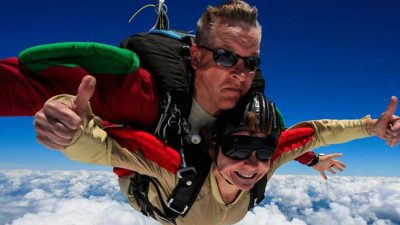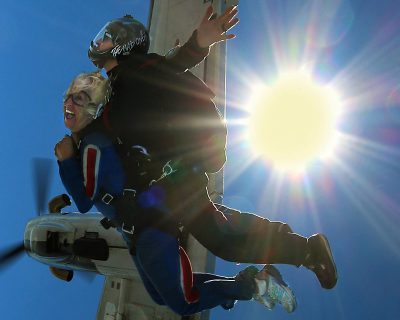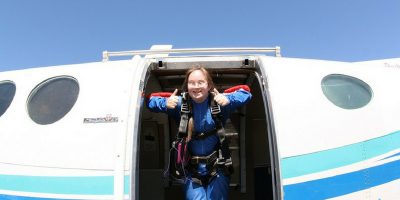Skydiving safety, rules! And it is all because of, well, skydiving safety rules! (See the difference there?)
Rules: we usually have a love/hate relationship with them. As kids, it was hard to understand. It seemed rules were the purview of adults bent on rending every bit of fun they could from daily life. No running by the pool? Lame. No wrestling in the streets? Lame. No dessert before dinner? Double lame.
Now, as mature adults and parents, it has become clear that certain rules were implemented not as a way to thwart pleasure at every turn but, rather, to prevent incidents and mitigate risk (except the dessert before dinner one, that was just cruelty).
On a more serious note, we don’t joke around when it comes to skydiving rules. Skydiving is an extreme sport, and there are risks involved. It is the attentiveness to skydiving safety rules that allows us to participate and enjoy the sport we love while managing the risks involved. Below we’ll cover the basic skydiving rules you need to know and skydiving safety rules you may not be familiar with.

Skydiving Safety Rules: The Basics
Weight Restrictions
At Skydive Monroe, we have a weight limit of 225lbs for men and 170 lbs for women (please note that exceptions can be made for women above this weight limit based on fitness levels).
The weight restriction is in place for two reasons.
Reason 1: Parachute systems are only designed to bear a certain load of weight. After rigorous testing, each parachute system is issued a technical standard order by the Federal Aviation Administration (FAA). This order indicates the amount of weight that the system can hold. When completing a tandem skydive, the weight of the instructor, student, and gear must be no greater than 500 lbs. If this weight is exceeded, the parachute is not guaranteed to function properly.
Reason 2: To avoid undue risk, the skydiving harness needs to fit properly. Individuals who carry weight primarily at their stomach and thighs may find the skydiving experience incredibly uncomfortable. The pressure from an ill-fitting harness can cause a loss of circulation, nausea, and, in extreme circumstances, can result in a loss of consciousness.
To minimize risk, optimal skydiving candidates are height/weight proportionate. We have these weight restrictions in place not to be discriminatory but, rather, with the safety and comfort of our customers in mind.
Alcohol Consumption
Alcohol and skydiving do not mix. Because alcohol impairs judgment, it is not a good idea to imbibe before an experience that allows for a very little margin of error. During your tandem skydive, from the time you board the aircraft to the time your toes touch down on the ground, you need to be able to remain alert, responsive, and able to follow the instructions that your instructor gives you. As thrilling as it is, tandem skydiving isn’t just a “ride”: you are an active participant and have a role to play. Furthermore, alcohol consumption prior to skydiving is prohibited in the Federal Aviation Regulations issued by the Federal Aviation Administration.
No Cameras Under 200 jumps
You might think that we don’t allow our tandem customers to bring their own Go-pros in order for us to sell video services in-house. However, the rule regarding the use of camera equipment is an industry standard. Skydivers that wish to jump with a camera need to have 200 jumps or a C license.
Freefall can be pretty overwhelming your first time. Between the sensory overload and the distraction of a camera, you might stray from the guidelines you were given in your pre-jump briefing and cause serious issues.
Additionally, even the smallest camera poses a big risk. If your Go-pro becomes snagged in just one line of the opening parachute, it can have grave consequences for both you and your instructor. It’s better off to leave the filming to the professionals.
Procedures (Training)
Before every skydive, tandem skydiving students are required to receive a pre-jump briefing. During this briefing, an instructor will go over entering and exiting the aircraft, the proper body position for freefall, and the proper landing technique. It is important to listen to this briefing and do your best to follow the directions you’ve been given. Proper body position is one of the easiest ways to help ensure your skydive goes as smoothly as possible.
Weather
As you may imagine, because the sky is our playground, some of the most stringent skydiving rules revolve around the weather. Cloudy skies, high winds, and rain are all no-gos for skydiving operations. To conduct safe jump operations, weather conditions have to be optimal. We know it can be frustrating to wait, but when it comes to weather, we have your well-being in mind.

Skydiving Safety Rules: What You Didn’t Know
Instructor Requirements
Skydiving rules even extend to the amount of experience an individual must have before becoming an instructor. In order to become a tandem skydiving instructor, an individual must have held an instructional rating, possess a D license (the most advanced of the skydiving licenses), accrued 500 jumps, have at least three years of experience in the sport of skydiving, and possess a Class III flight medical issued by the FAA.
Exit Order
In order to avoid collisions in freefall and unnecessary traffic while parachutists are under canopy, there are specific skydiving rules that determine the boarding and exit order of different types and groups of skydivers. Assuming all jumpers are going to altitude this is the exit order for skydiving: groups of jumpers participating in relative work (or belly flying) large to small, free flyers (jumpers in head up and head down orientations) large to small, student skydivers, tandem skydivers, wingsuit jumpers, and last but not least any individual deploying the parachute at a high altitude (usually right out of the door or within 3-5 seconds of exit). This skydiving rule helps ensure there is enough horizontal and vertical separation between groups.

Reserve Parachute
All skydivers are required to jump a dual parachute system. This means that within every skydiving “backpack” there are two parachutes: a main parachute and a reserve parachute. Furthermore, there are skydiving rules specific to the reserve parachute. Every 180 days the reserve parachute must be inspected and repacked by an FAA certified parachute rigger.
Automatic Activation Device
The automatic activation device is a small uber precise computer installed in parachuting equipment that tracks the rate of descent and altitude. In the event that there is an issue deploying the main parachute, the AAD will fire and deploy the reserve parachute. As not only a skydiving staple but a skydiving rule (See Federal Aviation Regulation Sec. 105.45), all of the skydiving equipment used in tandem skydiving operations and skydiving student operations are equipped with Automatic Activation Devices.
Skydiving Safety, Rules!
We won’t go so far as to say that “rules are cool.” But, we sure do love being able to enjoy skydiving in a manner that mitigates risk and maximizes fun precisely because of the rules that are in place. Interested in learning more about specific skydiving rules at Skydive Monroe? Give us a call!
Copyright © 2025, Skydive Monroe, All Rights Reserved.
DropZone Web Design & Marketing by Beyond Marketing, LLC



